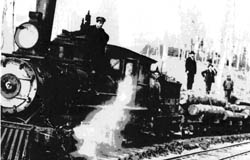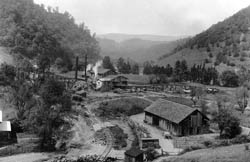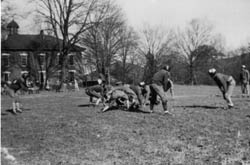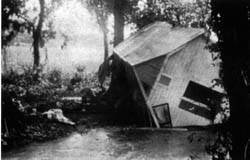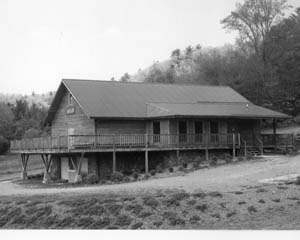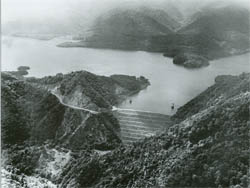|
A Brief History of Butler, TN & The Surrounding Area John Honeycutt first settled Butler in 1768. He built an arbor shelter and lean-to where the Roan Creek from the northeastern mountains ran into the Watauga River which came from the southeastern mountains. Honeycutt later built a cabin and was joined by James Millican and a few years later a Mr. Smith built a gristmill. By 1820 there were fifty families living here and the settlement became known as Smith's Mill because of the large mill Ezekiel Smith operated on the Roan Creek. The trip to the county seat at Elizabethton required traveling over several mountains and crossing large rivers several times; therefore, local citizens were very involved in the movement to establish a county separate from Carter County. Johnson County was organized in 1836 and named for Thomas Johnson, an early leader deceased in 1835 but who had owned property on Roan and Doe Creeks and in the upper part of the county.
Roderick R. Butler was a leader in the 13th Regiment and after the Civil War the town was re-named Butler for him. Joshua Perkins was the first postmaster.
The railroad came to Butler in 1902 and provided the means to reach markets with lumber, finished wood products, iron ore and farm produce. Local citizens, including students as well as visitors were afforded a good means of transportation by the railroad. The town flourished and became both an eductional and trading center.
McCain's Mill
L.L. Maples founded the Aenon Seminary which became Watauga Academy. Finley Curtis and David Farthing established a large mercantile business.
An abundance of water resources made Butler a good location for habitation;however, the overabundance of water in the form of floods caused the town's death knell. With the advent of the violent killer flood of 1940, the powerful Tennessee Valley Authority made a decision to build a dam flooding the town of Butler and all the valleys surrounding it. Butler is the only town ever flooded by the Tennessee Valley Authority. The Butler and Watauga Valley Heritage Museum opened in 2000 to honor the memory of the citizens of Butler and all others of the Watauga, Roan and Elk Valleys. Butler lives on in our minds and especially in our hearts.
|
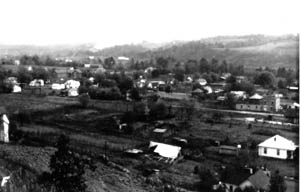 1930 |
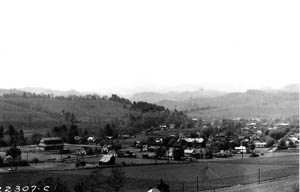 1946 Prior to the dam being completed |
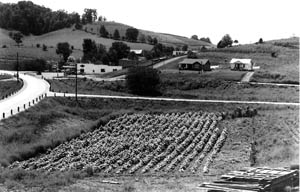 1953 Butler, TN relocated |
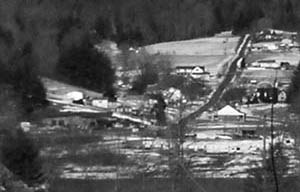 2000 |
The Watauga Dam
The Watauga Dam is a rock and earth filled dam. At the time of its completion it was the highest of its kind. A total of 1,484,700 cubic yards of compacted clay is at the dams core. On the two sides of the core 2,000,000 cubic yards of rock were piled. The design of the dam was to build it in a terrace-like design. On December 1, 1948 the gates of the Watauga Dam were closed. Nearly 12,000 acres of land had been acquired, 761 families were relocated. On August 29, 1948 the dam started generating power. The Watauga powerhouse is 2100 feet downstream from the bottom of the Watauga Dam. It contains an overhead crane, main transformers, generators and their turbines along with their equipment. The two generators rated at 30,000 kWh each. A control building houses office space and control equipment for not only the Watauga powerhouse, but the South Holston and Wilbur Dams as well. The Watauga Lake is 16 miles long and a shoreline of 109 miles. Total cost of the project was $32,335,243.00.
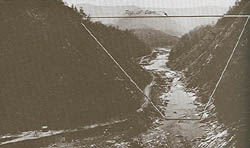
Dam site at Carden Bluf and
the area to be filled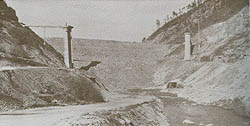
Near Completion
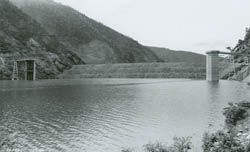 Completed 1949 |
|
 Controlled by the Confederate army of occupation during the Civil War, the loyal Johnson County citizens were largely brutalized. The Union 13th Regiment Tennessee Volunteer Cavalry was organized in 1863 and provided some protection from the Confederate home guards.
Controlled by the Confederate army of occupation during the Civil War, the loyal Johnson County citizens were largely brutalized. The Union 13th Regiment Tennessee Volunteer Cavalry was organized in 1863 and provided some protection from the Confederate home guards. 